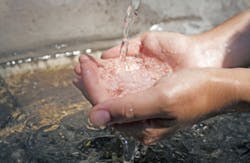Some of the most important ingredients for protecting our health include the inorganic minerals calcium, magnesium, copper, zinc and silver. Of these, copper and silver have long-term antimicrobial potency and are easily dispersed electrolytically into water in ionic or nanoparticle form.
Silver: This element has been known for centuries as an effective bacteria and virus killer. Silver sulphadiazine is the standard antibacterial treatment for burns and open wounds, and silver nitrate is used to protect the eyes of newborns. Some activated carbon filters for drinking water purification are impregnated with silver to prevent bacterial buildup. Silver is also used in drinking water treatment by airlines and passenger ships.
The National Aeronautics and Space Administration (NASA) designed a silver ionization system for its Apollo flights. The Johnson Space Center developed an electrolytic silver ion generator weighing only 9 ounces, requiring minimal power and no astronaut monitoring. Installed in the potable water supply and wastewater systems, the device would dispense silver ions to eliminate bacteria and viruses.
Copper: Copper is also now recognized as one of the best algae killers, and oxides and sulfates of copper are used in pesticides, algaecides and fungicides. Pool stores sell copper-based algaecide to kill black algae, the toughest of all.
Ions affect cell walls
When copper and silver ions and nanoparticles are released into water, these cations (positively charged) are a potent microbicide. These ions bond with negatively charged areas on the microorganism’s cell walls, affecting cell wall permeability and minimizing the intake of life-sustaining nutrients.
Inside an algae cell, copper and silver attack sulfur-containing amino acid radicals in the proteins used for photosynthesis. Photosynthesis and reproductive processes are blocked, leading to cell lysis (disintegration) and death.
The greatest benefit of copper and silver is that they remain active in water, providing long-term residual, non-toxic protection against recontamination. They remain in water until they flocculate, or form masses with algae and bacteria and then become large enough to be removed by filtration.
Cathodic ionization
One type of purification system using this principle has a microprocessor control and pair of electrodes consisting of alloys of copper and silver set slightly apart from each other.
Water is passed through a flow-cell chamber housing the electrodes, which are fed a low-voltage DC current. The amount of ions introduced into the water is directly proportional to the current controlled by the microprocessor. More advanced technologies now use broad-spectrum, high-frequency pulsed DC with pulse rise times of 50 nanoseconds.
To avoid electroplating of the cathodes and adhesion of oxides and organic debris, electrical current polarity is switched alternately every five minutes. This polarity change assures cleanliness and balanced wear on the two electrodes.
The better copper/silver ionization purification systems can be used in waters with wide variations in electrical conductivity. However, if the water is very pure and has an electrical conductivity of less than 200 microsiemens, voltages higher than the usual 7-12 volts must be used, up to 48 volts. On the other end of the scale, extremely conductive saltwater could cause overload if current is not limited.
Residual effect
One advantage of copper and silver ionization is that both substances are retained in trace amounts in the water and continue to have an antimicrobial effect over weeks and months. Even after the ionization system has been switched off, the effect persists.
The trace amounts of copper required for swimming pool purification and prevention of algae formation is between 0.5 and 0.7 milligrams per liter (mg/L), or parts per million (ppm).
In its Secondary Drinking Water Regulations, the US Environmental Protection Agency has determined that the maximum contaminant level (MCL) of copper in drinking water is 1.0 ppm, and that of silver is 0.1 ppm.
Some applications
Many swimming pool users have silver-based pool sanitation systems, which produce no odor or corrosion, no bleaching of clothing, and no formation of unwanted oxidizing compounds.
Biofilms, which are complex aggregations of microorganisms with a protective and adhesive matrix, are often found lining pipes in breweries, power stations, evaporative condensers and humidifiers. However, several bacteria known to be human pathogens die within hours when placed on copper alloy surfaces. Studies suggest that using copper alloys for surfaces exposed to human touch or food contact can help reduce the transmission of potentially infectious organisms.
John Stewart is a biomedical scientist and head of research for the Biophysica Corp., a producer of water treatment equipment and other products, based in Toronto, Ontario. More information is available at the company’s website: www.biophysica.com.


